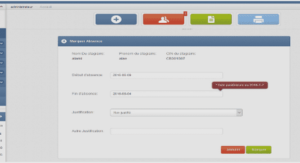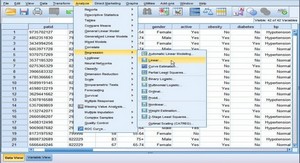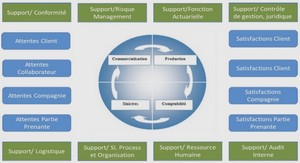Household Income (INC)
Household income is a strong background variable determining water use and demand. Average monthly income in Algeria is around 39.900 DA in 2016 (ONS: National Statistics Office; http://www.ons.dz/). Higher income class constitutes people having average monthly income above 100.000 DA. Households having average monthly income less than 39.900 DA are categorized as lower income class. Generally, people with higher income are more concern about water but their lifestyle is differing from lower income group people. Table 3.4 shows that the mean of monthly income is about 53 905 DA with minimum equal to 35 000 DA and maximum equal to 110 000 DA. Table 3.7 and figures 3.19 demonstrated that 6 % of the respondents fall in the high-income class, while 7% of respondents belong to class of lower income and 87% falls in middle-income category. Table 3.7 Distribution of sample based on monthly income Income Classes Interval Frequency Percentage Lower Income Middle Income Higher Income < 39 900 DA 40 000_990 000 DA > 100 000 DA 15 174 12 7 % 87 % 6 % Total 201 100 % Fig 3.19 Distribution of sample based on income categorization Chapter 03: Data Collection 45 3.4.2.5.Cars related parameters Three parameters of cars related are: existence, number (CARN) and washing frequency. For car possession (EXC) 87% of households have at least one car (figure 3.20). Fig 3.20 Cars possession Fig 3.21 Repartition of buildings according to cars number Fig 3.22 Frequency of washing cars per month From table 3.4 above, mean value of number of cars is equal to two cars, minimum and maximum number of cars are equal to zero and three cars per house, respectively. Figure 3.21 demonstrates the repartition of cars in the study area. For cars washing behaviors (WCAR), figure 3.22 demonstrates the frequency of washing cars in houses. 53% washing their cars one time per month, 19% washing their cars 2 times per month, 7% washing their cars 3 times per month and 8% of residents washing their cars 4 times per month. Table 3.4 shows that the mean of WCAR is equal to two.
Indoor Habits of Residents (INH)
Indoor Habits of Residents (INH) summarize all water related practices frequencies: Washing Dishes (WDISH), Washing Clothes (WCL), Using Toilets (UTLT), Shower for Female (FSHW) and Shower for Male (MSHW). The statistical characteristics of domestic water component is presented in table 3.8. The daily and weekly water usage was determined based on residents answers, which it collected according to the questionnaire paper.
Washing Clothes (WCL)
Table 3.8 above shows that the mean of WCL per week is equal to two, the minimum and maximum frequency of washing clothes are one and four times per week. Bar chart in figure 3.23 depicted the frequency (number of time) of washing clothes per households as following: 41.29% (83) wash their clothes once a week 49.26% (99) wash their clothes twice a week 7.46% (15) wash their clothes 3 times per week 1.99% (4) wash their clothes 4 times per week. Fig 3.23 Distribution of households according to the frequency washing clothes Chapter 03: Data Collection 47 The following distribution explained by Algerian behaviors in washing clothes that generally correspond to weekend only and due also to water distribution system (frequency of water supplying).
Washing Dishes (WDISH)
The frequency of dishwashing ranges between once and three times a day and shows that the houses could be categorized into three main groups (figure 3.24). The reason why majority of houses have a frequency of three times a day correspond to three main dishes a day (breakfast, lunch and dinner). 6.47% (13) wash dishes one time per day. 29.85% (60) wash dishes 2 times per day. 63.68% (128) wash dishes 3 times per day. Fig 3.24 Distribution of households according to the frequency of washing dishes 3.4.3.3.Using Toilets (UTLT) Data in the table 3.8 above shows that, the mean usage of toilet is four. The minimum and maximum frequency of using toilets are three and seven times per day. Bar chart in Figure 3.25 depicted the frequency of using toilets per day per person as following: 17.91% (36) use toilets 3 times per day. 43.28% (87) use toilets 4 times per day. 29.35% (59) use toilets 5 times per day. 6.47% (13) use toilets 6 times per day. 2.99% (6) use toilets 7 times per day.
Showering
Showering frequencies vary considerably from house to house and person to person. Showering is also related to gender. For Females (FSHW) the bath use mean is 2 (table 3.8) above). The minimum and maximum frequency of taking shower are 1 and 7 times per week. Bar chart in Figure 3.26 showed the frequency of taking shower per week per households as following: 19. 90% (40) of females take shower for once weekly. 35. 82% (72) of females take shower for 2 times per week. 31.84% (64) of females take shower for 3 times per week. 11.44% (23) of females take shower for 4 times per week. 0.50% (1) of females take shower for 5 times per week. 0.50% (1) of females take shower daily. Fig 3.26 Distribution of households according to the frequency of showering for female Data in the table 3.8 above shows that, the mean of MSHW is equal to 2. The minimum and maximum frequency of taking shower for males are 1 and 5 times per week. Bar chart in Figure 3.27 showed the frequency (number of time) of showering for males per week per households as following: 33.83% (68) of males take shower for one time per week. 34.82% (70) of males take shower for 2 times per week. 23.88% (48) of males take shower for 3 times per week. 6.97% (14) of males take shower for 4 times per week. 0.50% (1) of males take shower for 5 times per week. Fig 3.27 Distribution of households according to the frequency of showering for males Chapter 03: Data Collection 49 3.4.3.5.Who use More Water Inside Every House, Male or Female? Generally, women use more water inside every house. Highest number of liters used by women is for the household activities. Data reflect that around 47.26% (95) of people answered that women use more water than men for domestic purpose, whereas around 44.78% (90) of answers goes to male and the rest of percentage 7.96% (16) is for those answering that both male and female use the same quantity of water (Figure 3.28). Women are requiring more water because they are involved in performing maximum number of domestic works. Fig 3.28 Opinion poll about the use of water between male and female These values of domestic water use were expected considering the different factors influencing consumption, besides the period of records was associated to nearly summer conditions, in which high temperatures occurred.





